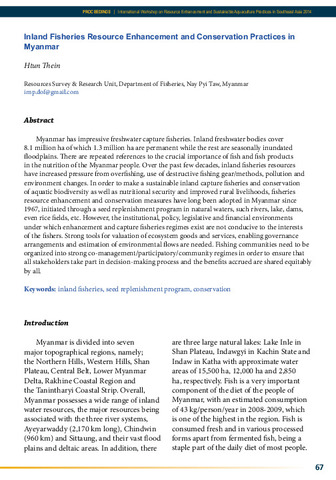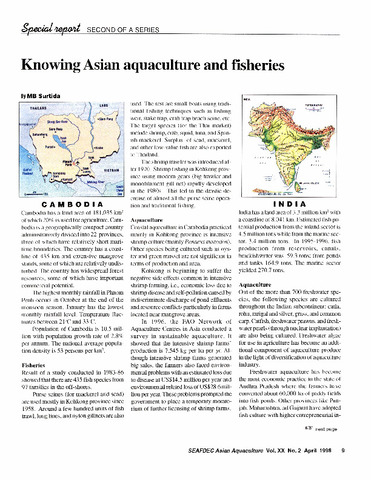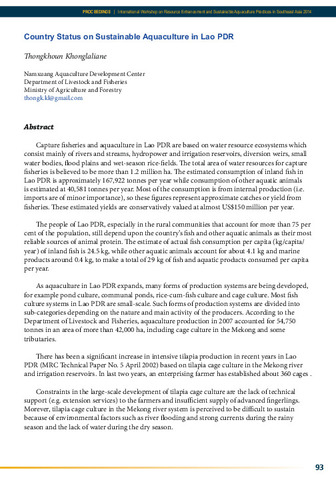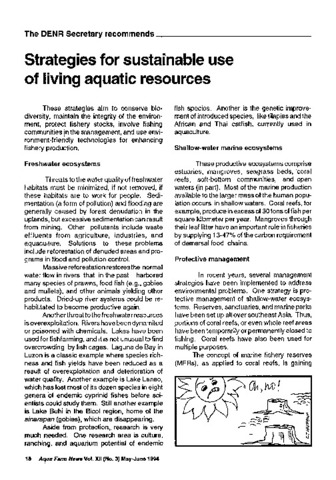Inland fisheries resource enhancement and conservation practices in Myanmar
| dc.contributor.author | Thein, Htun | |
| dc.contributor.editor | Romana-Eguia, Maria Rowena R. | |
| dc.contributor.editor | Parado-Estepa, Fe D. | |
| dc.contributor.editor | Salayo, Nerissa D. | |
| dc.contributor.editor | Lebata-Ramos, Ma. Junemie Hazel | |
| dc.date.accessioned | 2016-01-19T09:59:55Z | |
| dc.date.available | 2016-01-19T09:59:55Z | |
| dc.date.issued | 2015 | |
| dc.identifier.citation | Thein, H. (2015). Inland fisheries resource enhancement and conservation practices in Myanmar. In M. R. R. Romana-Eguia, F. D. Parado-Estepa, N. D. Salayo, & M. J. H. Lebata-Ramos (Eds.), Resource Enhancement and Sustainable Aquaculture Practices in Southeast Asia: Challenges in Responsible Production of Aquatic Species: Proceedings of the International Workshop on Resource Enhancement and Sustainable Aquaculture Practices in Southeast Asia 2014 (RESA) (pp. 67-75). Tigbauan, Iloilo, Philippines: Aquaculture Dept., Southeast Asian Fisheries Development Center. | en |
| dc.identifier.isbn | 9789719931041 | |
| dc.identifier.uri | http://hdl.handle.net/10862/2764 | |
| dc.description.abstract | Myanmar has impressive freshwater capture fisheries. Inland freshwater bodies cover 8.1 million ha of which 1.3 million ha are permanent while the rest are seasonally inundated floodplains. There are repeated references to the crucial importance of fish and fish products in the nutrition of the Myanmar people. Over the past few decades, inland fisheries resources have increased pressure from overfishing, use of destructive fishing gear/methods, pollution and environment changes. In order to make a sustainable inland capture fisheries and conservation of aquatic biodiversity as well as nutritional security and improved rural livelihoods, fisheries resource enhancement and conservation measures have long been adopted in Myanmar since 1967, initiated through a seed replenishment program in natural waters, such rivers, lake, dams, even rice fields, etc. However, the institutional, policy, legislative and financial environments under which enhancement and capture fisheries regimes exist are not conducive to the interests of the fishers. Strong tools for valuation of ecosystem goods and services, enabling governance arrangements and estimation of environmental flows are needed. Fishing communities need to be organized into strong co-management/participatory/community regimes in order to ensure that all stakeholders take part in decision-making process and the benefits accrued are shared equitably by all. | en |
| dc.language.iso | en | en |
| dc.publisher | Aquaculture Department, Southeast Asian Fisheries Development Center | en |
| dc.subject | Seed replenishment program | en |
| dc.subject | Myanmar | en |
| dc.title | Inland fisheries resource enhancement and conservation practices in Myanmar | en |
| dc.type | Conference paper | en |
| dc.citation.spage | 67 | |
| dc.citation.epage | 75 | |
| dc.citation.conferenceTitle | Resource Enhancement and Sustainable Aquaculture Practices in Southeast Asia: Challenges in Responsible Production of Aquatic Species: Proceedings of the International Workshop on Resource Enhancement and Sustainable Aquaculture Practices in Southeast Asia 2014 (RESA) | en |
| dc.subject.asfa | inland waters | en |
| dc.subject.asfa | policies | en |
| dc.subject.asfa | stocking (organisms) | en |
| dc.subject.asfa | sustainable fishing | en |
| dc.subject.asfa | fishery management | en |
| dc.subject.asfa | resource conservation | en |
| dc.subject.asfa | inland fisheries | en |
| dc.subject.asfa | fishery organizations | en |
| dc.subject.asfa | sustainable development | en |
| dc.subject.asfa | fishery regulations | en |
| dc.subject.asfa | inland water environment | en |
| dc.subject.asfa | sustainability | en |





